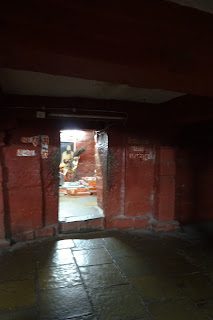At Ujjain railway
station we engaged an autorickshaw for visiting various temples. We agreed to
pay him three hundred and fifty rupees. We rented a small room in a small hotel
just for the purpose of taking bath. The autorickshaw took us to several
temples, importantly:
Sandipani (Shandhipani)
Ashram: This is where Lord Krishna, in the company of Balram, studied under the
tutelage of Rishi Sandipani. The Ashram has since been converted into a temple.
There is a stepped well inside the Ashram. The atmosphere inside the Ashram was
quite calm and serene.
Shri Mangalnath
Temple: Located on the banks of Shipra river, the temple is dedicated to Lord
Shiva. The earliest Meridian (of earth) is claimed to have passed through this
place, and hence the place is believed to be very significant for astrological
studies.
Harsiddhi Temple,
believed to have been built by King Vikramaditya. Legendary beliefs say that
the elbow of Kali fell at the spot where the temple is built.
Shri Kalbhairav
Temple, believed to have been built by the King Bhadrasen, several centuries
ago. Here, the main offering to the Lord is brandy, besides the customary flowers.
It was really funny to watch the Lord consuming litres and litres of brandy as
the pundit pours down the mouth of the statue of the deity the brandy brought
by devotees, and nobody knows where the brandy drains.
Bartrihari Caves: It
is believed that King Vikramaditya’s step brother renounced his worldly life and
chose to spend his remaining life in meditation in these caves. The caves were
so narrow, deep, and small that it could hurt claustrophobic people.
Ghadhkali Temple: It
is here Kalidas got his boon from Devi Maa. Some scholars believe that during
7th century this ancient temple was reconstructed by King Harshwardhan of
Thaneshwar when he visited Ujjain. It is indeed the most ancient temple of
Ujjain. The former Gwalior rulers rebuilt this holy shrine to its former glory.
On our way back to the
main Mahakaleshwar Temple, we stopped briefly at Vikramaditya Temple and Bada
Ganesh Temple – both on the roadsides and quite small. We also stopped over at Ram
Ghat on the banks of Kshipra river, where the Kumbh Mela takes places once in 4
years.
There was a very long
queue of devotees in front of Mahakaleshwar Temple, where one of the 12 Jyothirlingas
is located. We learned that it could take several hours for free darshan.
Fortunately, there was a special darshan, paying an entry ticket of Rs.250/-
per head and we chose the short cut. We had very good darshan of Lord
Mahakaleshwar. As they have built a kind of stepped platforms in front of the
deity for managing the queue we could stand in front of the deity for longer
time.
We took a Volvo AC
bus and reached Indore by the evening. We checked into our hotel for the
night’s stay.
The hotel was located
in a busy area, surrounded by shops, restaurants, multiplex cinema theatre,
etc., and we had a stroll to the nearby places in the evening.
Next morning, we
decided to take a public bus to Omkareshwar, the other Jyothirlinga. It was a
pity that there was no direct bus to Omkareshwar from Indore, despite the place
being an important holy place. After nearly four hours, after changing a bus on
the way, we were at Omkareshwar bus stand, which is another about a kilometer
from the temple. An autorickshaw dropped us near the bridge to cross Narmada
River to reach the temple.
Narmadha is an
amazing river, the lifeline of Madhya Pradesh, 1312 kilometers long, originating
in the Amarkantak plateau, and draining through the Gulf of Khambat into the Arabian
Sea. It flows from East to West, rather the longest West flowing river. It also
forms a kind of border between the northern and southern India.
At the Omkareshwar
Temple, there was a chaotic crowd to have darshan of the Lord. Besides, the
darshan was to have a break for an hour or so at 12.20 pm, and so, everyone pushed
and crushed everyone else to enter the sanctum before the gates were closed. We
were fortunate that we were also pushed inside the gate to have a very brief
darshan of Omkareshwar. Virtually, everyone was pushed out from the sanctum.
We took a boat to
cross the river to reach the Mamalleshwar, which taken together with
Omkareshwar, his twin, is considered one of the 12 Jyothirlingas. Hardly, any
crowd was here in this temple. We had good darshan, then finished our lunch,
took a bus and returned back to Indore by the evening.
Next morning, we
packed our things, left our luggage in the hotel itself, and departed for
Mandu, an historical place. Again, we decided to use the public transport, and
there was no direct bus. After changing over at Dhar, we reached Mandu after
nearly three hours or so. Only taxis plied inside Mandu for sightseeing. We
visited a number of historical mahals, masjids, and temples. Overall, I wasn’t
so much impressed about the place, having seen several Islamic structures at
various places in India. However, they all look beautiful in pictures.
The same evening, we
took a late-evening bus and reached Bhopal by around 11 at night and checked
into our hotel.
The next report will
be our final on our Madhya Pradesh Tour.














No comments:
Post a Comment